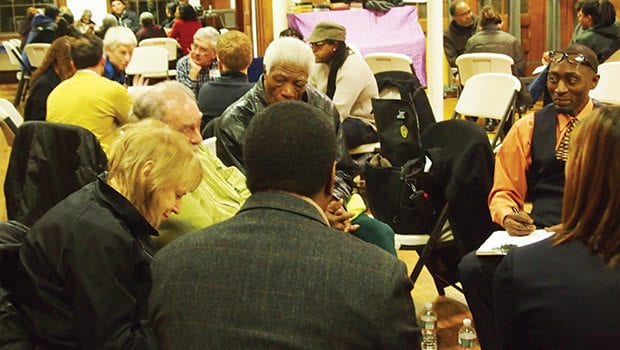
For years the Fairmount Line commuter rail trains roared through Mattapan and Dorchester, and for years community-based organizations worked to get stops added to the line in the neighborhoods where public transit dependence is high and public transit options are few.
Now, as the Fairmount Line is in the process of transitioning into a rapid transit line with new stations in Roxbury, Dorchester and Mattapan, as well as weekend service, Charlie Card access and free transfers to the subway at South Station, many of the activists who worked on the line are wondering whether they will be able to afford to remain in the neighborhoods along the line once the improvements are completed.
In Codman Square, long-term residents commonly see rent increases of $500 a month, according to Codman Square Neighborhood Development Corporation Executive Director Gail Lattimore.
“Now the neighborhood is becoming more desirable,” she said. “We’re one of the last neighborhoods that’s really affordable.”
On Dec. 7, Lattimore led neighborhood residents and activists in a discussion of gentrification along the Fairmount Corridor at a meeting sponsored by organizations including City Life/Vida Urbana, the Codman Square NDC, the Dorchester Bay EDC, the Southwest Boston CDC and the Right to the City Coalition.
“It’s really about displacement,” Lattimore said. “That’s the key issue. What happens to low- and moderate-income people as people of means move in.”
The Codman Square NDC conducted a survey of 75 households in the neighborhood to assess the effects of gentrification on residents. The survey found that 50 percent have seen a rent increase since 2011. The survey respondents, half of whom were homeowners, overwhelmingly (70 percent) approved of changes in the Codman Square area, but 40 percent expressed worry about paying bills and 50 percent about paying rent or mortgages.
“People are not sure they’ll be able to stay in their neighborhood,” Lattimore said. “As we welcome new residents into the neighborhood, we have to be very conscious of what it means to have people with higher incomes moving in.”
At the same time, many current property owners are being solicited by real estate speculators. Homeowner Marilyn Freeman held up a hand-written letter she received from a real estate investor offering her cash for the home she has lived in since 1967. “Do you have a property you’d like to sell without the going through the process of listing it?” she read from the letter.
“Other neighbors who are receiving these letters are elderly,” Freeman said. “And they don’t have the means to make repairs on their homes. And they’re biting.”
The Codman Square NDC survey found that 18 percent of respondents were rejected for a refinance loan on their homes in the last five years.
The community development corporations that advocated for rapid transit service and additional stops on the Fairmount line have pursued a strategy in recent years of acquiring land within a half-mile radius of the new stations for the development of affordable housing. The CDCs were successful in developing 800 new units and will complete another 200 within the next four years.
Aside from the Codman Square study, much of the evidence of gentrification is anecdotal. In Hyde Park, Southwest Corridor CDC Executive Director Matt Thal said it’s too soon to determine whether gentrification has taken root. But Thal said the question is more ‘when’ than ‘whether.’
“I’m sure Hyde Park is the next neighborhood that will be overwhelmed in a big way the way Jamaica Plain was,” he said.
Now that rents and purchase prices are rising more rapidly, the CDCs will likely need to pursue more aggressive tactics to help keep residents in their homes. Among the ideas discussed at Sunday’s forum were land trusts which would remove properties from the speculative market, more mixed-income developments and increased tenant protections against rent increases.
Speaking after the meeting, former City Councilor Chuck Turner cited re-instituting a form of rent control and developing limited-equity co-ops and land trusts as strategies to fight gentrification.
“Gentrification is the free market system,” he said. “People buy houses because they want to see them increase in value. We have to focus on ending the use of housing as a commodity.”
City Life/Vida Urbana Executive Director Lisa Owens Pinto said community-based organizations will have to work together to protect neighborhood residents from displacement as property values in the city increase.
“We have to work with our allies to develop ways to create systemic policy change,” she said. “There’s no magic-bullet affordable housing strategy. The city does not have the resources to meet the demand for affordable housing moving forward.”







